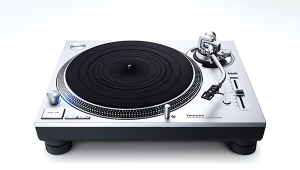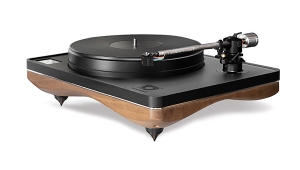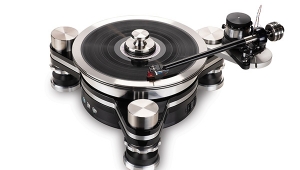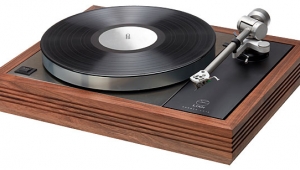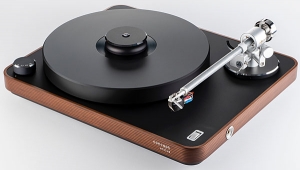| Columns Retired Columns & Blogs |
VPI HW-19 turntable Anthony H. Cordesman August 1985
Anthony H. Cordesman reviewed the HW19 Mk.II in August 1985 (Vol.8 No.4):
Footnote 1: Usually, problems associated with shaky furni ture are caused by turntables that do not isolate well from lateral vibration, rather than vertical. This is especially likely in a turntable like the VPI, which uses an extremely heavy subchassis requiring fairly sturdy springs.—Larry Archibald
If you're as tired of audio cultism as I am, you'll love the latest version of Harry Weisfeld's VPI HW19 turntable, the Mark II: no tricks, no mysticism, no bulishit physics, just a straightforward turntable that offers a solid middle ground between the SOTA and the Oracle, with many of the Goidmund's vir tues as well.
The HW19-II looks like a well-styled turntable; you can even use it without religious rituals in the setup. Not only that, once set-up it stays set-up. Only the SOTA exceeds it in terms of ability to perform well in virtually any location on any furniture.
It may have taken Harry Weisfeld nearly half a decade to get the VPI to this point, but the HW19-II is my current candidate for America's best buy in high-end turntables. It provides as much information in a musically natural way over as wide a range of frequencies as any product I have ever had the opportunity to listen to, and does so with convincing balance on all types of music.
Technical Details
The HW19-I1 uses a heavy-duty AC synchronous motor. The practical result is enough torque to ignore stiction and drag problems. I can't say that immunity to powerline fluctuations is any better than the SOTA—I played around with some trick computer power supplies to vary voltage and frequency and both tables did splendidly; even with small shifts in line voltage, most turntables, even expensive ones, change sound character somewhat.
I have no idea how God would design a turntable platter or mat, although I'm enough of a heretic to suspect He wouldn't bother. That makes me willing to settle for what you get with the HW19-II as standard equipment. You get a platter machined from a block of 1"-thick acrylic with a 6 lb ring of lead on the bottom. Because of the location of the lead near the circumference of the platter, VPI claims this is equivalent to a 20lb solid-aluminum platter. The VPI platter now follows the lead of Goldmund in using a platter material that roughly matches the record, doesn't need a mat, and still has enough mass to provide good bass.
The spindle is threaded to accept a hard plastic clamp that locks the record down. The result is excellent coupling and a remarkably flat playing surface, with information retrieval equal to the best I've heard. In fact, the VPI HW19-II seems to do a slightly better job of coupling the record and damping resonance, while retaining musical data, than the Goldmund, Oracle, or SOTA Star Sapphire—all of which do very well, indeed.
You also get a nicely machined spindle and bearing. To be honest, I have no idea as to whether ruby, sintered bronze, chrome, tungsten carbide, or diamond is the best bearing material—the turntables that I rank at the top all seem to use different materials. The HW19-II also exhibits no audible bearing problems, and the assembly is built like the proverbial brick listening room. There is no hint of wow or rumble—something hinted at by much of the British, Swiss, and Japanese competition. You can move the unit easily with no risk of adjustment problems, and even adjust bearing height.
The VPI uses a massive 36 lb floating chassis with two layers of welded and folded-together 10-gauge steel. I don't know if this is what makes it more resistant to acoustic breakthrough, but it is better damped than any turntable I've tried, including some of the super-high–mass Micro Seikis. The unit is amazingly solid; it makes the Linn Sondek and Pink Triangle look a little like toys.
The VPT uses a four-point suspension that resonates at about 3.5Hz, which is claimed to make it resistant to building vibration, subsonic air conditioning noise, and many other problems. It rivals the Oracle for stability, and exceeds it in mass damping capability. At the same time, the SOTAs can take far more movement of the furniture on which they are mounted without audible disturbance (footnote 1). The SOTAs are so good in this respect that they remain the unquestionable choice for anyone whose turntable mount is slightly shaky, or whose floors move around under an otherwise stable cabinet.
Rounding Up The Usual Suspects
I have yet to hear the SOTA Star Sapphire with its new mat, but the new VPI provides a significantly more detailed and natural upper midrange and high end than did the SOTA Sapphire with its old mat, and is even slightly better in these areas than the SOTA Sapphire with its new mat (see SWW's report in Vol.8 No.3). These differences are particularly evident on chamber music, female voice, and jazz having a great deal of upper-midrange and treble content. The SOTAs are excellent turntables, but, even with their new mats (at least the Sapphire), have a trace of solidity or dullness in this area.
Compared to the Oracle (though perhaps not to the Delphi II, which I haven't heard), the YPI has more convincing and solid bass. The midranges are about equal, although the VPI provides a bit more smoothness, the Oracle slightly more convincing dynamics. The VPI's upper octaves are very good, but not quite as good as the Oracle's. They are distinctly better than the "live" but less detailed upper midrange and highs of the Linn, and the VPI's bass and pitch stability are far more convincing than the Pink Triangle's.
This is not to say that the the HW19-II is a world beater; the SOTAs and the Oracle remain serious rivals, and both can form the core of superb front end. Lovers of the SOTA extol its more extended bass; Oracle fans can claim that a properly set up Oracle has the cleanest highs around —and are probably correct. I may have sold my SOTA Sapphire after comparing it to the VPI, but I have kept my Star Sapphire and look forward to trying it out, with its new mat, against the VPI.
I'm convinced, however, that the more high priced, delicate, tweaky, and cultish British turntables like the Linn and Pink Triangle are no longer competitive. I see no reason why you should have to accept low torque, trick adjustments, or fun and games with lead dress and tonearm clearance. The Linn and Pink Triangle can be good turntables with the right set up; the world just doesn't need more cults and aggravation at the prices these manufacturers charge. Nor does it need special furniture, trick power supplies, or various add-ons just for normal operation.
The VPI HWI9AI is for people who listen to music. Virtually any tonearm can be easily mounted and adjusted on the VPI, the record clamping mechanism works with a wide range of warped records, and there s no need for cable tweaking. Only the SOTAs are easier to set-up.
Several Thousand Adjectives About The Sound
Shall we begin with "liquid," "transparent," "cream-colored," "extended stage width," or what?
Sorry, you're not going to get such descriptions from me; I feel they do much more harm than good when you're trying to build a high-end system. My experience indicates that the better turntables are extremely hard to characterize sonically, except in the broadest terms.
First, I find that the tonearm tends to have a large effect in far more areas than do the differences between the VPI, SOTA, and Oracle. Particularly affected is the midrange, especially in terms of apparent speed, resonant coloration, and the stability of soundstage characteristics. The tonearm can also be primary in its effect on deep bass.
Related to this is the cartridge/tonearm interface, which can produce misleading im pressions about turntables. The SOTA un questionably has fewer problems with most tonearms than does the competition (footnote 2); the Oracle and VPI do very well. You will have to try a number of tonearm and turntable combinations to discover the broad character of a turntable's sound.
Third, the tonearm mounting board material can be critical. Wood usually produces a damped, controlled sound with good bass and some loss of transients. Heavy plastic returns the transient life and preserves most of the bass, but with added resonance and less control in the bass. Metal mounting plates and live, thin metal supports under the mounting plate tend to offer lots of life and energy, but add a touch of hardness and exaggerated dynamics.
Fourth, your resultant sound characteristic can be altered by changing the platter mat. Sticky mats cure resonances, but are often dull and lack musical life. Vacuum platters restore much of this life without as many resonances, but are highly variable (one from another, rather than record-to-record). Felt and metal mats add life, but usually at the costs of a fair amount of bass, unpredictable midrange resonances, and a touch of hardness. Hard plastic mats or platters provide the best combination of damping and life, but only if records are firmly clamped to them; otherwise they're too lively.
Fifth, acoustic breakthrough is going to be different in different rooms and with different furniture. The VPI, SOTAs, and Oracle tend to minimize these effects, but I have heard minor effects when moving either the SOTA or the VPI even a few inches. The ARs, Linns, and Pink Triangles are far too sensitive for my taste. The high-mass turntables are unpredictable; they require rigid, non-vibrating floors, a virtual impossibility in many homes, and totally impossible in apartment buildings. (High-rise apartments are particularly subject to constant subsonic vibration.)
Sixth, many turntables are under-torqued to the point where even a 2-gram tracking force can produce very faint changes in speed on passages that are difficult to track. And many turntables are far too sensitive to power-line fluctuations. I regard these probiems, along with acute furniture sensitivity, as evidence of obsolete and unacceptable designs; they have no place in today's market.
Let's not kid around. If you want the kind of hype that ignores these realities, go read it. My descriptions of the differences between the VPI HWI9-II and its key rivals are close to the limit of what you will hear using a wide range of tonearms and cartridges under a reasonably wide range of listening conditions.
Summing Up
The VPI HW19-II is in the excellent middle ground between the SOTAs and the Oracle. I hear excellent bass, midrange, and highs, and a remarkable freedom from the coolrations that show up on prolonged listening. The VPI mixes musical life with good damping of resonances, and preserves a good soundstage. The SOTA sounds slightly farther back in the hall, and the soundstage is slightly smaller, and not as deep. The Oracle sounds more forward, with a big sounds tage that also lacks a bit of depth.
Change a few parameters in your particue lar listening environment, however, and...The truth is that you have to start talking about a tonearm/cartridge/turntable system, an impossibly full Pandora's box for the reviewer. Try your own combination, and be true to your own ears and taste.
In this price range, it is critical that you listen in depth to any combination of turntable, cartridge, and arm before you buy. And be sure you listen to the actual samples ybu're thinking of purchasing. The dealer may try to talk you out of it, but don't give in. Even the same brand can sound very different because of slight changes in cartridge and tonearm manufacture, assembly, etc.
You're entitled to listen to what you buy, and entitled to the dealer's best shot at set up. You should also give the dealer the opportunity to show you why a new cartridge or tonearm may sound better. A really good dealer will have spent a long time getting good combinations together, and you can both profit by giving him a fair opportunity to demonstrate his expertise.
Check for wow and rumble, and look over the sample for cosmetic problems. A good dealer should be able to demonstrate wow and rumble performance on ordinary music in a few minutes. Speed accuracy over time is a snap using a strobe. I'd also put in for a 30-day money-back guarantee if something goes wrong. Most of the better units are in short stock—but that's not your problem! If you can't get an immediate exchange, get your money back.
I don't know if this is the twilight of the turntable or the beginning of its renaissance. The important thing is that there are now three broadly distributed high-end turntables made in North America that are all of high quality. The VPI HW19-II joins the SOTA and Oracle in providing top-quality sound without an outrageous import mark up. For my money, the HWI9-II has the edge over, its immediate rivals. But, who knows? Tomorrow it may be SOTA or Oracle. The key point is that you can build an excellent, grief-free system around any of the three brands if you're willing to show a little care in buying, understand that you have to match turntable, arm, and cartridge, and are willing to listen&3151;and trust your own ears.—Anthony H. Cordesman
Footnote 1: Usually, problems associated with shaky furni ture are caused by turntables that do not isolate well from lateral vibration, rather than vertical. This is especially likely in a turntable like the VPI, which uses an extremely heavy subchassis requiring fairly sturdy springs.—Larry Archibald
Footnote 2: An exception is the Technics EPA-500, whose RCA phono jacks exit horizontally; there is room on the SOTA to attach cables only if they have right-angle connectors.—J. Gordon Holt
- Log in or register to post comments
